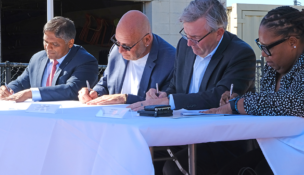Roaring ’20s repeat possible, Richmond Fed president says
Barkin predicts goods inflation will ease as supply issues lessen
Roaring ’20s repeat possible, Richmond Fed president says
Barkin predicts goods inflation will ease as supply issues lessen
Federal Reserve Bank of Richmond President and CEO Thomas Barkin said he could visualize another round of the “roaring ’20s,” he said Thursday during the Virginia Bankers Association/Virginia Chamber 2022 Financial Forecast event. Driven by investment and real estate appreciation, the nation has seen a 28% boost in household net worth over the past two years, a $32 trillion increase.
“Businesses are reporting record profits and strong balance sheets,” he said. “Inventories are low. States are seeing sizable surpluses.” All of these factors should sustain demand, he added.
However, Barkin said he expected labor shortages to continue over the short term, and supply issues to last for another 10 to 12 months. Manufacturers will likely get some breathing room this quarter as demand for products drops after the holidays, he noted.
COVID-19 and its variants continue to be a wild card, Barkin said, with outbreaks due to delta and then omicron strains causing work absences and child care difficulties. Barkin warned that he had underestimated inflation in 2021, and joked that economic forecasters were created to make weather forecasters look good.
As people begin to view the coronavirus as more of an endemic than a pandemic, “COVID has now largely become a supply side and an inflationary challenge,” Barkin said, pointing to airline travel over the holidays as an example. People wanted to fly, but airlines couldn’t find enough flight crews, he said. Numerous flights were canceled due to staff members’ COVID exposures and bad weather.
Barkin said he also expects inflation in the prices of goods to reduce as supply chain pressures ease. The real escalation in inflation has been from goods, he said, with about a 6.3% inflation rate, higher than the 0.2% decrease a year that the U.S. saw over the last five years, not counting the two pandemic years.
Services inflation, by contrast, has remained roughly in line with the past five years, Barkin said, although he expects labor shortages to pressure the prices of services.
“Price hasn’t yet had its say,” Barkin said. Normally, when prices increase, the quantity in demand decreases. He hasn’t yet seen that, he said. For example, retailers are prioritizing availability over pricing. Supply chain redesign could also increase prices.
The past two years taught the U.S. several lessons, Barkin said. The $6 trillion in federal stimulus money fueled the U.S. economic recovery, and the nation’s GDP is now 1.4% higher than it was in the fourth quarter of 2019. Consequences of the spending, though, are that demands for goods increased — up 16% now — and broke supply chains; workers were slow to return to the labor force, potentially because of payments; and national debt increased.
This week, Federal Reserve Chairman Jerome Powell, who spoke before the U.S. Senate Committee on Banking, Housing and Urban Affairs for his confirmation hearing Tuesday, said that the central bank will likely raise interest rates several times this year, as well as other tightening measures to fight inflation.
The Fed has started the process of normalization, Barkin said Thursday. In November 2021, Fed officials began tapering asset purchases, and at the board of governors’ December meeting, they accelerated the taper, which is expected to end by mid-March.
s















